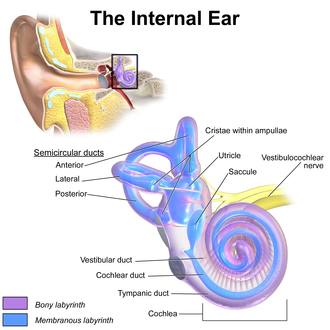Saccule
| Saccule | |
|---|---|

Inner ear, showing saccule near center.
|
|

illustration of otolith organs showing detail of utricle, , endolymph, cupula, Macula of saccule, hair cell filaments, and saccular nerve
|
|
| Details | |
| Identifiers | |
| Latin | sacculus |
| MeSH | A09.246.631.909.625 |
| TA | A15.3.03.065 |
| FMA | 61116 |
|
Anatomical terminology
[]
|
|
The saccule is a bed of sensory cells situated in the inner ear. The saccule translates head movements into neural impulses which the brain can interpret. The saccule detects linear accelerations and head tilts in the vertical plane. When the head moves vertically, the sensory cells of the saccule are disturbed and the neurons connected to them begin transmitting impulses to the brain. These impulses travel along the vestibular portion of the eighth cranial nerve to the vestibular nuclei in the brainstem.
The vestibular system is important in maintaining balance, or equilibrium. The vestibular system includes the saccule, utricle, and the three semicircular canals. The vestibule is the name of the fluid-filled, membranous duct than contains these organs of balance. The vestibule is encased in the temporal bone of the skull.
The saccule, or sacculus, is the smaller of the two vestibular sacs. It is globular in form and lies in the recessus sphæricus near the opening of the scala vestibuli of the cochlea. Its cavity does not directly communicate with that of the utricle. The anterior part of the saccule exhibits an oval thickening, the macula acustica sacculi, or macula, to which are distributed the saccular filaments of the vestibular branch of the vestibulocochlear nerve, also known as the statoacoustic nerve or cranial nerve VIII.
Within the macula are hair cells, each having a hair bundle on the apical aspect. The hair bundle is composed of a single kinocilium and many (at least 70) stereocilia. Stereocilia are connected to mechanically gated ion channels in the hair cell plasma membrane via tip links. Supporting cells interdigitate between hair cells and secrete the otolithic membrane, a thick, gelatinous layer of glycoprotein. Covering the surface of the otolithic membrane are otoliths, which are crystals of calcium carbonate. For this reason, the saccule is sometimes called an "otolithic organ."
...
Wikipedia

